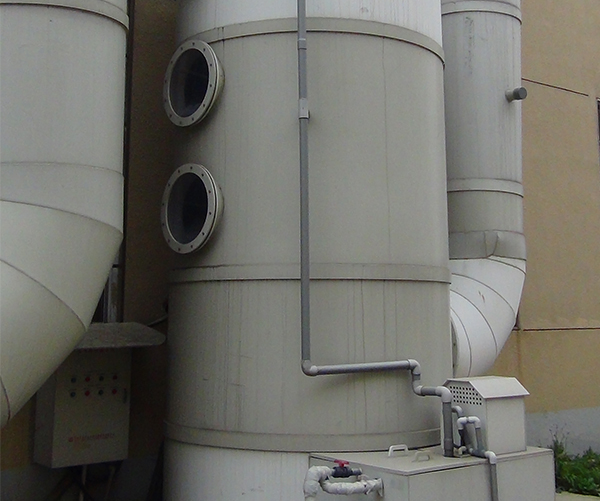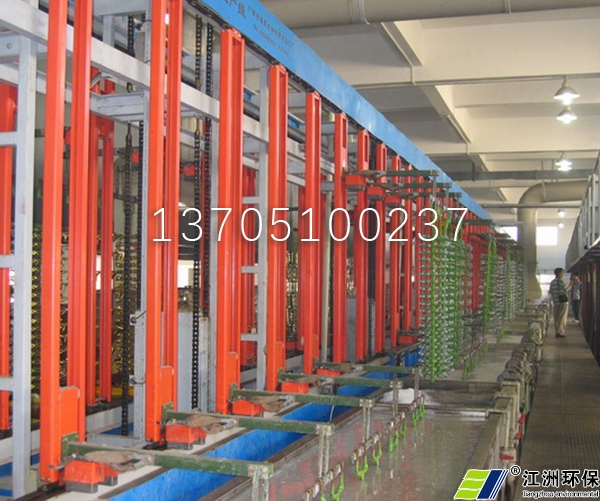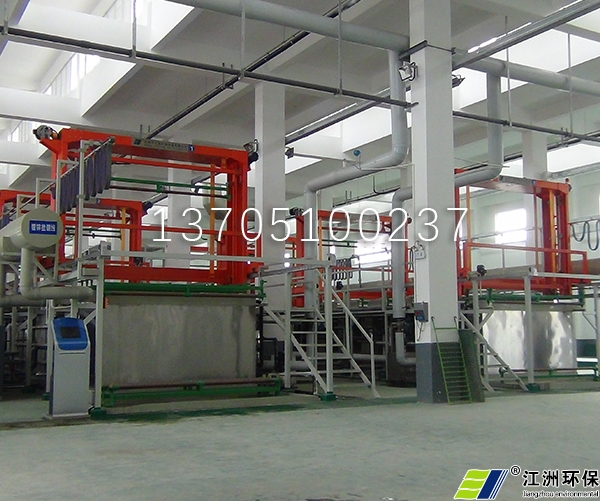At present, our country deals with Electroplating wastewater treatment equipment The commonly used methods for electroplating wastewater from electroplating include chemical method, biological method, physicochemical method and electrochemical method.
Chemical method
Chemical method is to decompose toxic and harmful substances into non-toxic and harmless substances by redox reaction or neutralization precipitation reaction, or directly remove heavy metals from wastewater by precipitation or flotation.
1. Precipitation method
(1) Neutralization precipitation method. Alkali is added to the wastewater containing heavy metals for neutralization reaction, so that heavy metals can be separated in the form of insoluble hydroxide precipitation. Neutralization sedimentation method is simple in operation and is a commonly used method for wastewater treatment.
(2) Sulfide precipitation method. The method of removing heavy metal ions in wastewater by adding sulfide to generate sulfide precipitation. Compared with neutralization precipitation method, sulfide precipitation method has the following advantages: the solubility of heavy metal sulfide is lower than that of its hydroxide, the reaction pH value is between 7 and 9, and the treated wastewater generally does not need neutralization, so the treatment effect is better. However, the disadvantage of sulfide precipitation method is that sulfide precipitation particles are small and easy to form colloids. Sulfide precipitation remains in water and generates gas when encountering acid, which may cause secondary pollution.
(3) Chelating precipitation method. High molecular heavy metal capture and precipitation agent (DTCR) reacts rapidly with heavy metal ions such as Hg2+, Cd2+, Cu2+, Pb2+, Mn2+, Ni2+, Zn2+and Cr3+in wastewater at room temperature to generate insoluble chelate salts, and then a small amount of organic or (and) inorganic flocculants are added to form flocculent sedimentation, so as to achieve the purpose of capturing and removing heavy metals. The characteristics of DTCR series medicaments for electroplating wastewater treatment are that they can remove multiple heavy metal ions at the same time, and can also play a good removal effect in the case of heavy metal ions existing in the form of complex salts. The removal of colloidal heavy metals is not affected by coexisting salts, and has a good development prospect.
2. Oxidation method
By adding oxidants, the toxic substances in electroplating wastewater are oxidized into non-toxic or low toxic substances, which are mainly used to treat CN -, Fe2+, Mn2+low valence ions in wastewater, various organic substances causing chromaticity, obscurity and smell, and pathogenic microorganisms. For example, when treating cyanide containing wastewater, hypochlorite is often used to oxidize the cyanide ion under alkaline conditions to decompose it into low toxic cyanate, and then further degrade it into non-toxic carbon dioxide and nitrogen.
3. Chemical reduction
The most typical chemical reduction method in electroplating wastewater treatment is the treatment of chromium containing wastewater. The method is to add reducing agents FeS04, NaHS03, Na2S03, S02 or iron powder into the wastewater to reduce Cr (Ⅵ) to Cr (III), and then add NaOH or lime milk for precipitation and separation. The advantages of this method are simple equipment, less investment and large treatment capacity, but secondary pollution caused by sediment sludge should be prevented.
4. Neutralization method
Through acid-base neutralization reaction, adjust the pH of electroplating wastewater to make it neutral or near neutral or within the pH range suitable for further treatment, which is mainly used to treat the pickling wastewater of electroplating plants.
5. Air flotation
As a new technology to treat electroplating wastewater, air flotation is developed in recent years. The basic principle is to use a high-pressure water pump to pressurize the water to several atmospheres and inject it into the dissolving tank, so that the gas and water can be mixed into dissolved water. The dissolved water enters the pool through the dissolved air releaser. Due to the sudden decompression, the dissolved air in the water forms a large number of micro bubbles, which stick together with the condensate produced by the preliminary treatment of electroplating wastewater, Make its relative density less than water and float to the water surface to become scum, so as to purify the wastewater.
Biological method
Biological treatment is a new technology for electroplating wastewater treatment. Some microbial metabolites can change the valence of heavy metal ions in wastewater. At the same time, the microbial flora itself has strong biological flocculation and electrostatic adsorption, which can adsorb metal ions, so that heavy metals can enter the sludge cake after solid-liquid separation, so that wastewater can be discharged or reused up to standard.
1. Biosorption
Derivatives prepared by objects or organisms with the ability to separate metals from solution are called biosorbents. Biosorbents are mainly bacteria, algae and some extracts. The adsorption mechanism of heavy metals by microorganisms depends on many physical and chemical factors, such as light, temperature, pH value, heavy metal content and chemical form, other ions, the presence of chelating agent and the pretreatment of adsorbent. Biosorption technology has certain advantages in the treatment of heavy metal pollution. Under the condition of low content, biosorbent can selectively adsorb heavy metals in it, and is less affected by the interference of calcium and magnesium ions in aqueous solution. The method has high treatment efficiency, no secondary pollution and can effectively recover some precious metals. However, the biological growth environment is not easy to control, and a large number of poisoning deaths are often caused by changes in water quality.
2. Bioflocculation
Bioflocculation is a kind of decontamination method that uses microorganisms or metabolites produced by microorganisms to flocculate and precipitate. Microbial flocculant is a kind of natural macromolecular material produced by microorganism itself, which has high flocculation efficiency. Its main components are glycoprotein, mucopolysaccharide, cellulose, protein and nucleic acid. It has high charge or strong hydrophilicity and hydrophobicity, and can adsorb multiple colloidal particles with particles through ionic bond, hydrogen bond and van der Waals force at the same time, creating bridging phenomenon between particles, forming a three-dimensional network structure and settling down. At present, there are about a dozen varieties of biological flocculants that can flocculate heavy metals. The amino and hydroxyl groups in biological flocculants can form stable chelates with heavy metal ions such as Cu 2+, Hg 2+, Ag+, Au 2+and precipitate. This method is safe, convenient, non-toxic, does not produce secondary pollution, has wide flocculation range, high flocculation activity, fast growth, extensive flocculation conditions, is mostly not affected by ionic strength, pH value and temperature, and is easy to realize industrialization.
3. Biochemical method
Biochemical method is to remove soluble ions by converting them into insoluble compounds through direct chemical reaction between microorganisms and metal ions. Its advantages are: strong selectivity, large adsorption capacity, no use of chemicals. The metal content in the sludge is high, the secondary pollution is significantly reduced, and the heavy metals in the sludge are easy to recover, with a high recovery rate. However, its disadvantage is that the reaction efficiency of functional bacteria and metal ions in wastewater is not high, and the consumption of culture medium of culture bacteria is large, and the treatment cost is high.
Physico-chemical method
Physicochemical method is to remove impurities contained in electroplating wastewater by means of ion exchange or membrane separation or adsorbent. It is widely used in industry, usually in combination with other methods.
1. Ion exchange method
Ion exchange method is a method that uses ion exchanger to separate harmful substances from wastewater. The most commonly used exchanger is ion exchange resin, which can be reused after acid alkali regeneration after being saturated. Ion exchange is realized by ion exchange between free moving ions carried by the exchanger itself and ions in the treated solution. In most cases, ions are first adsorbed and then exchanged, with dual functions of adsorption and exchange. For wastewater containing chromium and other heavy metal ions, Cr (VI) can be removed by anion exchange resin, and Cr (III), iron and copper plasma can be removed by cation exchange resin. It is generally used to treat wastewater with low content of harmful substances. It has the advantages of recycling, turning harm into benefit, recycling water, etc., but it has high technical requirements and large one-time investment.
2. Membrane separation method
Membrane separation refers to the separation of different components in the mixture under the action of energy, content or chemical potential difference by using a semipermeable membrane as the barrier layer and by virtue of the selective permeation of the membrane. By using membrane separation technology, heavy metals and water resources can be recovered from electroplating wastewater, which can reduce or eliminate its environmental pollution and achieve clean production of electroplating. For electroplating wastewater with high added value, such as gold, silver, nickel, copper, etc., membrane separation technology can realize closed cycle and produce good economic benefits. For comprehensive electroplating wastewater, after simple physical and chemical treatment, most of the water can be reused by membrane separation technology, with a recovery rate of 60%~80%, reducing the total discharge of sewage and pollutants discharged into the water body.
3. Evaporation concentration method
This method is a treatment method for evaporation of electroplating wastewater, concentration of heavy metal wastewater, and recycling. It is generally applicable to the treatment of electroplating wastewater containing chromium, copper, silver, nickel and other heavy metals. At present, it is generally used as an auxiliary means of other methods. It has the disadvantages of large energy consumption, high cost, large floor area and high operating costs.
4. Activated carbon adsorption method
Activated carbon adsorption is an economical and effective method to treat electroplating wastewater, which is mainly used for wastewater containing chromium and cyanide. It is characterized by mild treatment and regulation, safe operation, and the deeply purified treated water can be reused. However, this method has the problems of complex regeneration of activated carbon and the regeneration solution can not be directly returned to the plating tank for use, and the adsorption capacity is small, so it is not suitable for wastewater with high content of harmful substances.
Electrochemical method
1. Electrolytic method
Electrolysis is the use of electrolysis to treat or recover heavy metals, which is generally applied to electroplating wastewater with high noble metal content or single electroplating wastewater. The electrolytic treatment of Cr (VI) uses iron as the electrode. The ferrous ion produced by the continuous dissolution of the iron anode can reduce Cr (VI) to Cr (III) under acidic conditions, and Cr (VI) is directly reduced to Cr (III) on the cathode. Since hydrogen ions are consumed in the electrolytic process, the remaining hydroxide ions in the water change the solution from acidic to alkaline, and generate chromium and iron hydroxide precipitation to remove chromium. The electrolytic method can remove multiple metal ions at the same time, and has the advantages of good purification effect, less sludge, small floor area, etc., but it consumes more electricity and steel, and is rarely used at present.
2. Galvanic cell method
Granular carbon, coal cinder or other conductive inert substances are used as cathode, iron filings as anode, and the conductive electrolyte in the waste water plays a conductive role to form a primary battery. The purpose of treating waste water is achieved through the primary battery reaction. In recent years, iron carbon micro electrolysis technology has received more and more attention in the treatment of electroplating wastewater.
3. Electrodialysis
Electrodialysis is a kind of membrane separation technology. It arranges the anion and cation exchange membranes alternately between the positive and negative electrodes, and separates them with a special separator. Under the action of electric field, with the potential difference as the driving force, the electrolyte is separated from the solution by using the selective permeability of the ion exchange membrane, so as to realize the concentration, desalination, refining and purification of electroplating wastewater.
4. Electrocoagulation gas floatation
Soluble anode (Fe, AI, etc.) materials are used to generate a large number of cations such as Fe2+, Fe3+, Al3+, etc., and precipitates such as Fe (OH) 2, Fe (OH) 3, AI (OH) 3 are generated through flocculation to remove pollutants in water. At the same time, a large number of H2 microbubbles are generated on the cathode, and a large number of O2 microbubbles are generated on the anode. These bubbles are used as air flotation carriers to float together with the flocculated sewage. A large number of flocs float up quickly with rich micro bubbles to purify water quality.
The conventional treatment technology of electroplating wastewater in China has been relatively mature. The modern biological method for electroplating wastewater treatment is a very promising wastewater treatment technology, which does not produce secondary pollution. The key is to use new technology to further treat it and further improve the effluent quality. Membrane treatment technology will play an important role in electroplating wastewater treatment in the future because of its high separation efficiency and the ability to recover heavy metals. At the same time, through the promotion of cleaner production process, reducing the amount of pollution discharge from all aspects of electroplating production and changing "passive treatment" to "active treatment" are also the fundamental methods to solve the pollution of electroplating wastewater.
development direction
China, like other countries, attaches great importance to the treatment of electroplating wastewater. In the past few decades, a lot of research work has been carried out on the treatment methods of electroplating wastewater, and the investment in treatment is also increasing. In the future, as in the past, efforts will be made to solve this problem. According to the treatment and research of electroplating wastewater at home and abroad, the development trend should be as follows:
Actively carry out comprehensive prevention and control
After decades of development, the treatment of electroplating wastewater has changed from simple "waste treatment" to comprehensive treatment, that is, a positive method of both prevention and recovery of resources. In the past, the cleaning process has been reformed in many ways, with remarkable results. For example, multi-stage countercurrent rinsing, reform of water tank design, change of hanging mode of plated parts, etc. These reforms have greatly reduced the carrying out of plating solution, not only recovered useful substances, but also reduced the burden and cost of electroplating wastewater treatment. Comprehensive treatment is the development trend of pollution prevention and control, and there are also many technical problems to be solved.
Develop closed loop
Closed circuit circulation is one of the most economical and effective ways to treat electroplating wastewater at present. It is the direction of treating electroplating wastewater, so as to realize basically zero discharge of electroplating rinse water. But so far, the problems such as the concentration control of the terminal tank and the application and operation of the ion exchange device have not been well solved.
Reforming electroplating process
Reforming electroplating process is the fundamental method to prevent and control pollution. Popularizing and applying various cyanide free, chromium free and other non polluting and less polluting electroplating processes can reduce the pollution source of wastewater. Cyanide free electroplating, low chromium passivation, replacing cadmium with zinc or tin zinc alloy, and the use of electrophoretic paint instead of electroplating are also increasing. At present, many units in China are exploring and practicing, but electroplating can not be completely replaced, and there are many specific problems to be solved.
Multivariate combination technology
In the treatment of electroplating wastewater, a single method is often difficult to meet the ideal requirements, and various combination methods will gradually replace a single treatment method. From the perspective of development trends at home and abroad, chemical methods tend to be the main method, supplemented by other combined processing technologies and automatic detection and control means. It is a development direction to research and develop multi-function combined processor. It can not only treat mixed electroplating wastewater with complex composition, but also miniaturize the process and equipment, thus saving floor space and project investment.
Social governance
There are many electroplating plants and a wide range of them. The waste sludge and concentrated waste liquid produced in production are relatively small and dispersed. At present, most of these substances are discharged directly, causing secondary pollution, except for a few comprehensive recovery units. Therefore, centralized recycling in one city and one region can be considered, and urban and regional recycling centers for electroplating waste residue and waste liquid can be established. In this way, not only the environment can be protected, but also waste can be turned into treasure. At the same time, investment can be saved, energy consumption can be reduced, and economic benefits can be improved. For example, the electroplating wastewater treatment center in Tianjin Development Zone has been completed, and its process is advanced, meeting the requirements of socialized treatment of electroplating wastewater. The process design adopts unit combination, which is reasonable and flexible, and has achieved the goals of resource reuse, closed circuit circulation, and minimum discharge, which is worth learning from and promoting.
strengthen management
To ensure the normal operation of wastewater treatment equipment is a necessary condition for pollution prevention. If the built wastewater treatment facilities can not operate normally, the wastewater treatment will exist in name only. Therefore, daily management must be strengthened, and rewards and punishments must be combined with the assessment of pollution control workers; Organize regular training, technical exchange and further study abroad for relevant personnel. In addition, laws and regulations should be formulated and systems should be improved. Each electroplating plant shall comply with ISO 9000 and ISO 14000 series standards as far as possible.

Electroplating, petrochemical and pharmaceutical industries are the three major polluting industries in the world today. It can be said that in the 20th century, the treatment of electroplating wastewater up to standard discharge is not complete. The development trend of electroplating wastewater treatment in the 21st century should be to completely eliminate pollution and strive to achieve zero discharge. In the treatment of electroplating wastewater in the future, reasonable treatment methods should be selected from the reality to carry out economic and effective comprehensive prevention and control of electroplating wastewater, strive for the coordination and unification of environmental benefits, economic benefits and social benefits, and truly realize cleaner production







